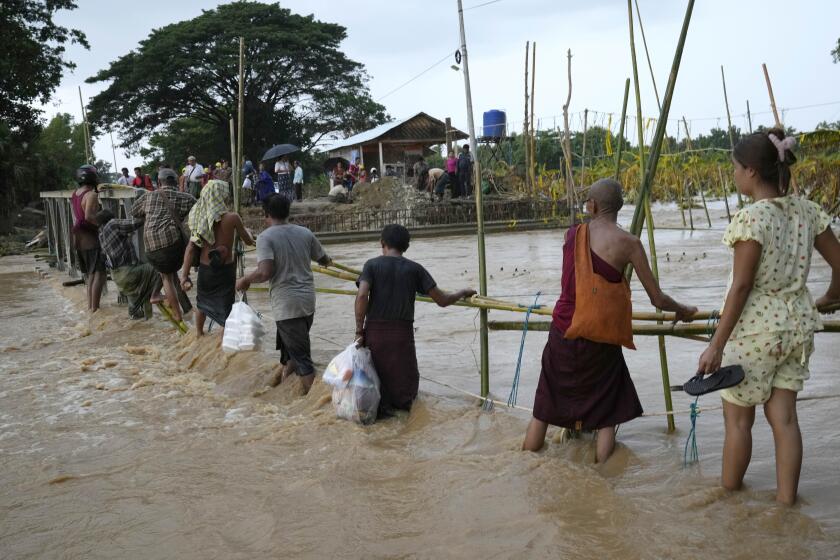The Ups and Downs of Driving in Yugoslavia
Yugoslavia’s Dalmatian Coast is lined by the blue Adriatic Sea, red-tile-roofed fishing villages and islands scattered liberally just offshore.
But what struck us as most awesome were its craggy, soaring mountains. Fully 75% of the country is covered by mountains and highlands, and it seemed as if we passed through nearly all of them in an 11-day driving trip.
While four-lane divided highways, financed by tolls, spread out from the major cities, most of the nation’s roads are two lanes, usually a generous two lanes.
The road through Montenegro in southern Yugoslavia snakes along the Moraca River in mountains that climb to 7,000 feet. It has 34 tunnels and bridges supported by stilts.
Almost everywhere we went in the tourist areas we found someone who spoke enough English, or German, to answer our questions for directions or help with menus. We took along a Serbo-Croatian phrase book, however, and in rural areas needed it to communicate.
You don’t need an international driving permit; a U.S. driver’s license is sufficient. We rented a Hertz Volkswagen Golf diesel, a Class E car, which was waiting at the Belgrade airport. We chose a stick shift not just for economy but for greater control on the mountain roads. Diesel was an economic fuel and in lower gears we had the acceleration we needed for passing slow trucks.
Our mileage averaged 12 to 18 kilometers per liter at 28 cents per liter ($1.06 a gallon). Coupons for a 5% gasoline discount are available at border entries, airports and train stations. The car cost $50 a day.
Planning a Route
The only map Hertz had for us was one prepared by the Yugoslavia National Tourist Office, which is not as detailed as one would wish. We had taken with us Hallwag’s map, with excellent markings and spellings as they appear on road signs. Detailed maps are also available in bookshops in Yugoslavia.
The country is 540 miles long and 240 wide. We chose a circular route to virtually every part of the country: northwest to Zagreb, south through Plitvice’s 16 lakes and east along the coast through Split to below Dubrovnik, with a side trip to Sarajevo, then inland to Skopje and back to Belgrade.
Virtually every town has a gasoline service station. The attendants still pump the fuel, although you may have to wash your own windshield. Restrooms typically were not too clean. Travelers soon learn to carry their own tissue and seat covers.
Yugoslavia provides a road assistance service on major highways.
Most Yugoslavian drivers are like everyone else, courageous or reckless, but certainly impatient. It was not unusual for an approaching car to pull out around traffic when there was not quite room to complete the pass and blink his lights to caution you.
Truck drivers were courteous, especially when it came to passing in the mountains. Some would blink their left turn signal when passing was unsafe and then the right when the way was clear.
On winding mountain roads with trucks grinding along at about 30 kilometers an hour, we found that the only way to make time was to pass whenever possible, regardless of whether there was a marked passing zone.
Caught in the Act
Before long I was doing it like the locals: Peek around the truck, a quick downshift, hit the accelerator and zap, you’re one truck ahead. Quick downshift, hit the accelerator and . . . oops! What’s that policeman doing up there in the middle of the road waving that little sign?
Yes, it happened. One of the milijicia spoke enough English to point out that I had passed on a curve.
Even if our phrase book had had the Serbo-Croatian words for “But officer, everyone is doing it,” I don’t think I would have tried it. He assessed an on-the-spot fine of 1,500 dinars and wrote out a receipt. Fortunately for me, the U.S. equivalent was only $1. But for a Yugoslav whose monthly salary may be only $100, that is plenty.
And be sure to use your safety belt--it’s compulsory in Yugoslavia.
For more information on travel to Yugoslavia, contact the Yugoslavia National Tourist Office, 630 Fifth Ave., Suite 280, New York 10111; (212) 757-2801.
More to Read
Sign up for Essential California
The most important California stories and recommendations in your inbox every morning.
You may occasionally receive promotional content from the Los Angeles Times.










